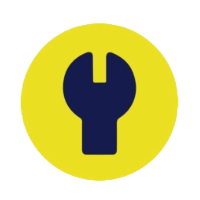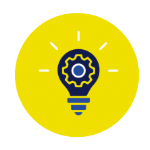Philanthropic support takes many forms. It can fund nonprofit programs that provide services directly to those in need; increase the capacity of systems so that multiple programs and organizations are more effective and efficient; support policy & advocacy initiatives that change the environment in which nonprofits work; and fund research & innovation with the potential for game-changing progress.
Across the many social impact areas our team has analyzed, philanthropic support typically falls into one or more of these four categories. Like financial investment asset classes, these categories often reflect different levels of risk, timeframes for results, and social impact returns.
To illustrate each philanthropic play, we provide an example of each drawn from our partner Lever for Change’s Bold Solutions Network. Lever for Change is an affiliate of the John D. and Catherine T. MacArthur Foundation, and Bold Solutions Network is its searchable database of vetted, high impact opportunities from among the highest ranked proposals from Lever for Change competitions. The following examples have undergone extensive evaluation and due diligence to ensure each solution promises real and measurable progress to accelerate social change.

Direct Services
Approximate timeframe for results
0-5 years
Risk/reward considerations
Strengths: Lower risk since generally less complex; often addresses immediate need; specific client/beneficiary outcomes are relatively easier to measure
Limitations: Doesn’t change underlying conditions or causes
Nonprofit Example: Responsible, Engaged, and Loving (REAL) Fathers
Build positive parenting skills of fathers in Uganda.
Read more
Impact and Innovations Development Centre’s (IIDC) REAL Fathers initiative is a community-led mentoring program for fathers of toddler-aged children in Uganda that teaches positive parenting and relationships. Community elders mentor young fathers ages 16 to 25 who are parenting children ages 1 to 5. Fathers in the program build positive parenting and nonviolent discipline skills, increase positive communication with their partner, use family planning tools, and learn to accept gender-equitable roles.
Young fathers participating in REAL were half as likely to use any form of violence with their partners and, one year later, participants were also half as likely to use physical child punishment.
Learn more: https://iidcug.org/

System Capacity Building
Approximate timeframe for results
5+ years
Risk/reward considerations
Strengths: Potential for more sustainable change
Limitations: Higher investment risk/uncertainty of results due to greater complexity (e.g., more players with potentially competing interests and incentives); progress can be harder to measure and attribute to any one funder’s work
Nonprofit Example: Jacaranda Health
Improve maternal health and newborn care in Kenya.
Read more
Drawing on its experience running private hospitals, Jacaranda Health works to ensure that government midwives in public hospitals have the skills to deliver life saving care through its emergency obstetric and newborn care (EmONC) mentorship program.
Jacaranda uses a “train the trainer” model. Experienced EmONC educators train other service providers to become mentors themselves. These mentors work within government health facilities to refresh providers’ EmONC knowledge & skills, support continuing medical education, and run simulations and direct coaching.
Jacaranda Health has supported its government partners in providing safe deliveries for 976,000 mothers and babies across over 1,110 public health facilities across Kenya since 2015.
Learn more: https://www.jacarandahealth.org/

Policy/Advocacy
Approximate timeframe for results
1-10+ years
Risk/reward considerations
Strengths: Can leverage resources of other stakeholders (e.g., government and business) in ways that lead to more widespread and sustainable change
Limitations: Higher investment risk/uncertainty of results including potential reputational/political risk; progress harder to measure
Nonprofit Example: Talent Beyond Boundaries
Create employment pathways for refugees.
Read more
Talent Beyond Boundaries (TBB) connects skilled refugees with employers that need their skills in countries around the world. However, even when displaced people find opportunities to work in a new country, they can face difficulties obtaining a visa. To overcome these difficulties, TBB works with governments, the private sector, refugees, and refugee-serving organizations to develop visa programs that are more flexible.
TBB has advocated for and helped to establish legal pathways that connect skilled refugees with hard-to-fill jobs in Australia, Canada, and the United Kingdom.
Learn more: https://www.talentbeyondboundaries.org/

Research/Innovation
Approximate timeframe for results
5-10+ years
Risk/reward considerations
Strengths: Breakthrough could lead to widespread change over the long term
Limitations: Higher investment risk/uncertainty (i.e., money and time may be spent learning only what doesn’t work)
Nonprofit Example: Carbon Leadership Forum
Reduce greenhouse gases through carbon-storing building materials.
Read more
Buildings and construction account for about 40% of energy-related greenhouse gas emissions, with much of that attributable to emissions produced by building materials. Carbon Leadership Forum is conducting research on the potential of creating carbon-storing building materials, which greatly reduce the amount of emissions buildings produce. Materials are made out of underutilized waste from agricultural products, like rice hulls, wheat straws, and sunflower stalks.
If these building materials are widely adopted, it will contribute to a reduction of over one gigaton of carbon. In addition, it will catalyze new manufacturing hubs in rural areas, create jobs, and reduce the need for traditional, emissions-intensive disposal methods of waste fibers.
Learn more: https://carbonleadershipforum.org/
Philanthropic Plays at a Glance
Entry Point
Approximate Time Frame for Results
Risk/Reward Considerations
Direct Services
0-5 years
Strengths: Lower risk since generally less complex; often addresses immediate need; specific client/beneficiary outcomes are relatively easier to measure
Limitations: Doesn’t change underlying conditions or causes
System Capacity Building
5+ years
Strengths: Potential for more sustainable change
Limitations: Higher investment/risk uncertainty of results due to greater complexity (e.g., more players with potentially competing (e.g., more player with potentially competing interests and incentives); progress can be harder to measure and attribute to any one funder’s work
Policy/Advocacy
1-10+ years
Strengths: Can leverage resources of other stakeholders (e.g., government and business) in ways that lead to more widespread and sustainable change
Limitations: Higher investment risk/uncertainty of results including potential reputational/political risk; progress harder to measure
Research/Innovation
5-10+ years
Strengths: Breakthrough could lead to widespread change over the long term
Limitations: Higher investment/risk uncertainty (i.e., money and time spent learning only what doesn’t work)
